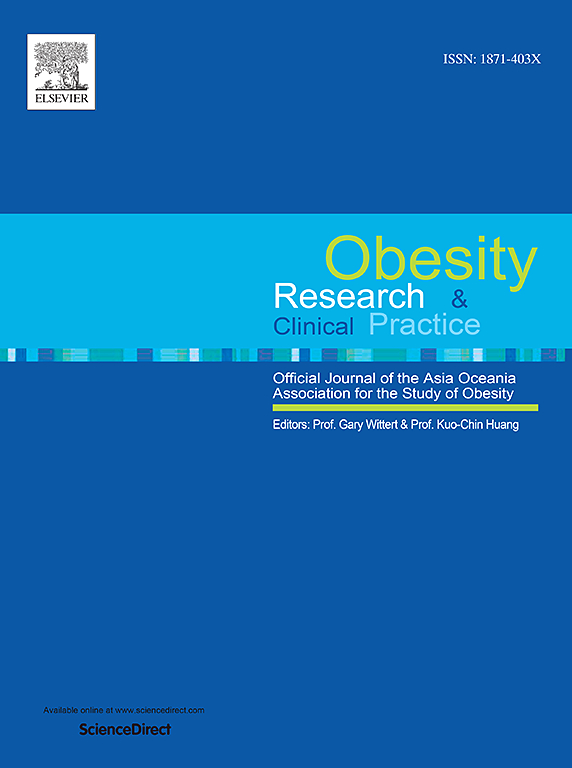利拉鲁肽对肥胖或超重人群身体成分的影响:系统综述。
IF 2.5
4区 医学
Q3 ENDOCRINOLOGY & METABOLISM
引用次数: 0
摘要
目的:评价利拉鲁肽对肥胖或超重人群体成分的影响。方法:系统检索PubMed、Embase和Cochrane图书馆数据库,检索时间截止到2024年6月10日。随机对照试验(rct)比较利拉鲁肽和安慰剂,并报告体成分结果。结果:分析了涉及960名参与者的15项研究的数据。在所有纳入的研究中,与安慰剂相比,利拉鲁肽始终显示出总体重、脂肪量和内脏脂肪组织(VAT)的显著降低。增值税降低幅度从12.49 %到23 %不等,突出了利拉鲁肽针对内脏脂肪的有效性,内脏脂肪是心脏代谢风险的关键因素。脂肪量的减少也是实质性的和一致的,加强了利拉鲁肽在改善整体身体成分方面的功效。相比之下,瘦体重的结果更加多变,一些研究报告瘦体重保持甚至增加,而另一些研究则表明瘦体重减少。结论:利拉鲁肽可有效降低脂肪量和VAT,支持其用于控制肥胖和相关的心脏代谢风险。然而,无法准确计算瘦肉和脂肪质量比例强调了标准化报告和个人数据可用性的必要性。未来的研究应优先考虑这些因素,并包括肌肉功能评估,以更好地评估GLP-1受体激动剂对身体成分的临床影响。本文章由计算机程序翻译,如有差异,请以英文原文为准。
Effects of liraglutide on body composition in people living with obesity or overweight: A systematic review
Aim
To evaluate the effect of liraglutide on body composition in people living with obesity or overweight.
Methods
A systematic search was conducted in PubMed, Embase, and Cochrane Library databases up to June 10, 2024. Randomized controlled trials (RCTs) comparing liraglutide to placebo and reporting body composition outcomes were included.
Results
Data from 15 studies involving 960 participants were analyzed. Liraglutide consistently demonstrated significant reductions in total weight, fat mass, and visceral adipose tissue (VAT) compared to placebo across the included studies. VAT reductions ranged from 12.49 % to 23 %, highlighting liraglutide's effectiveness in targeting visceral fat, a key factor in cardiometabolic risk. Fat mass reductions were also substantial and consistent, reinforcing the efficacy of liraglutide in improving overall body composition. In contrast, lean mass outcomes were more variable, with some studies reporting preservation or even gains in lean mass, while others indicated losses.
Conclusions
Liraglutide effectively reduces fat mass and VAT, supporting its use in managing obesity and related cardiometabolic risks. However, the inability to accurately calculate lean and fat mass proportions underscores the need for standardized reporting and availability of individual-level data. Future research should prioritize these elements and include muscle function assessments to better evaluate the clinical impacts of GLP-1 receptor agonists on body composition.
求助全文
通过发布文献求助,成功后即可免费获取论文全文。
去求助
来源期刊

Obesity research & clinical practice
医学-内分泌学与代谢
CiteScore
7.10
自引率
0.00%
发文量
80
审稿时长
49 days
期刊介绍:
The aim of Obesity Research & Clinical Practice (ORCP) is to publish high quality clinical and basic research relating to the epidemiology, mechanism, complications and treatment of obesity and the complication of obesity. Studies relating to the Asia Oceania region are particularly welcome, given the increasing burden of obesity in Asia Pacific, compounded by specific regional population-based and genetic issues, and the devastating personal and economic consequences. The journal aims to expose health care practitioners, clinical researchers, basic scientists, epidemiologists, and public health officials in the region to all areas of obesity research and practice. In addition to original research the ORCP publishes reviews, patient reports, short communications, and letters to the editor (including comments on published papers). The proceedings and abstracts of the Annual Meeting of the Asia Oceania Association for the Study of Obesity is published as a supplement each year.
 求助内容:
求助内容: 应助结果提醒方式:
应助结果提醒方式:


